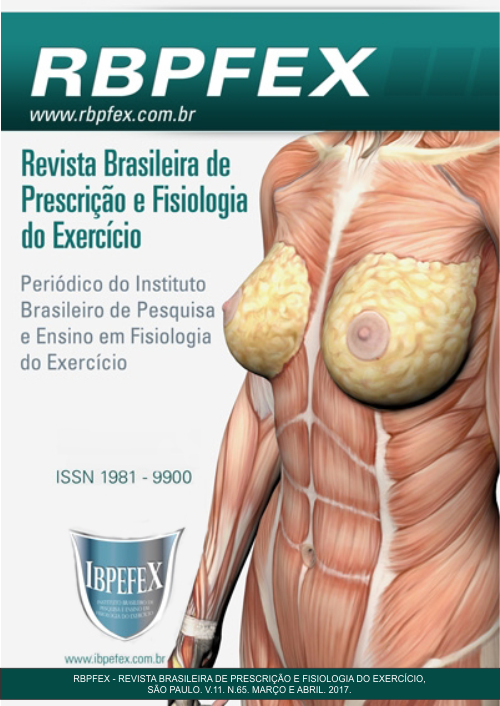Electromyographic study of the mae-geri stroke
Abstract
The surface electromyography can show the quality of muscle coordination, through it, we can verify the existence of disparities between the dominant and non-dominant limb of an individual. The mae-geri is a technique used by many karateka thus analyze the activation of the muscles involved in the movement makes it important to understand the biomechanical aspects involved in making the coup. The aim of the study was to analyze through EMG behavior of the main muscles involved in mae-geri blow. The study included four karatekas aged between half past six p.m. years. The activation of the rectus femoris and biceps femoris in 4 athletes showed distinct patterns in relation to the activation time and amplitude of the signal, however, it was observed in all athletes activation of two muscles together. The paired t-test showed a significant difference (p=0.006) for the rectus femoris muscle between the dominant and non-dominant, but in relation to the biceps femoris muscle were no significant differences (p=0.186). It was concluded that co-contraction is a factor in mae-geri, which can lead to joint stiffness, and thus reduce the strength and power of the kick. It was possible to identify differences in the mean amplitude of the electromyographic signal between the dominant and non-dominant limb. The negative values found in the ISB, and the test results paired t comparing the rectus femoris between the dominant and non-dominant limb, may indicate the existence of asymmetries related to the dominant and nondominant of karateka.
References
-Bere, T.; Kruczynski, J.; Veintimilla, N.; Hamu, Y.; Bahr, R. Injury risk is low among world-class the FIVB injury surveillance system. Br J Sports Med. Vol. 49. Num. 17. p. 1132-1137. 2015.
-Greene, A.; Stuelcken, M.; Smith, R.; Vanwanseele, B. The effect of external ankle support on the kinematics and kinetics of the lower limb during a side step cutting task in netballers. BMC Sports Sci Med Rehabil. Vol. 6. Num. 42. p. 1-10. 2014.
-Marques Junior, N. Periodização tática: uma nova organização do treinamento para duplas masculinas do voleibol na areia de alto rendimento. Rev Min Educ Fís. Vol. 14. Num. 1. p. 19-45. 2006.
-Marques Junior, N. Equipamento recomendado para proteger o voleibolista durante o jogo de voleibol. Lecturas: Educ Fís Dep. Vol. 19. Num. 192. p. 1-13. 2014.
-Marques Junior, N. Importância do estabilizador para prevenir a entorse de tornozelo do jogador de voleibol: um estudo de revisão. Revista Brasileira de Prescrição e Fisiologia do Exercício. Vol. 9. Num. 56. p. 721-729. 2015. Disponível em: <http://www.rbpfex.com.br/index.php/rbpfex/article/view/885>
-Marques Junior, N. Escala de prescrição da intensidade subjetiva do esforço do treino (PISE TREINO): elaboração e aplicação na sessão –parte 2. Rev Observatorio Dep. Vol. 2. Num. 2. p. 52-98. 2016.
-Marques Junior, N.; Barbosa, O. Lesão no tendão calcâneo de um atleta de voleibol: relato de experiência. Revista Brasileira de Prescrição e Fisiologia do Exercício. Vol.10. Num. 57. p. 29-66. 2016.Disponível em: <http://www.rbpfex.com.br/index.php/rbpfex/article/view/818/765>
-Marques Junior, N.; Arruda, D.; Nievola Neto, G. Validade e confiabilidade da escala de faces da percepção subjetiva da dor muscular do esforço físico do voleibol: um estudo durante a competição. Rev Observatorio Dep. Vol. 2. Num. 1. p. 26-62. 2016.
-Moreno, J.; Afonso, J.; Mesquita, I.; Ureña, A. Dynamics between playing activities and rest time in high level men`s volleyball. Int J Perf Analysis Sport. Vol. 16. Num. 1. p. 317-31. 2016.
-Palao, J.; Manzanares, P.; Valadés, D. Antrhopometric, physical, and age differences by the player position and the performance level in volleyball. J Hum Kinet. Vol. 44. p. 223-236. 2014.
-Reeser, J.; Verhagen, E.; Briner, W.; Askeland, T.; Bahr, R. Strategies for the prevention of volleyball related injuries. Br J Sports Med. Vol. 40. Num. 2. p. 594-600. 2006.
-Santos, M.; McIntire, K.; Foecking, J.; Liu, W. The effects of ankle bracing on motion of the knee and the hip joint during trunk rotation tasks. Clin Biomech. Vol. 19. Num. 9. p. 964-71. 2004.
-Shaw, M.; Gribble, P.; Frye, J. Ankle bracing, fatigue, and time to stabilization in collegiate volleyball athletes. J Athlet Train. Vol. 43. Num. 2. p. 164-171. 2008.
-Stoffel, K.; Nicholls, R.; Winata, A.; Dempsey, A.; Boyle, J.; Lloyd, D. Effect of ankle taping on knee and ankle joint biomechanics in sporting tasks. Med Sci Sports Exerc. Vol. 42. Num. 11. p. 2089-2097. 2010.
-Venesky, K.; Docherty, C.; Dapena, J.; Schrader, J. Prophylatic ankle braces and knee varus-valgus and internal-external rotation torque. J Athlet Train. Vol. 41. Num. 3. p. 239-244. 2006.
-West, T.; Campbell, N. The effect of ankle bracing on knee kinetics and kinematics during volleyball-specific tasks. Scand J Med Sci Sports. Vol. 24. Num. 6. p. 958-963. 2014.
-Zhang, S.; Wortley, M.; Silvernail, J.; Carson, D.; Paquetti, M. Do ankle braces provide similar effects on ankle biomechanical variables in subjects with and without chronic ankle instability during landing? J Sports Health Sci. Vol. 1. Num. 2. p. 114-120. 2012.
Authors who publish in this journal agree to the following terms:
- Authors retain the copyright and grant the journal the right of first publication, with work simultaneously licensed under the Creative Commons Attribution License BY-NC which allows the sharing of the work with acknowledgment of the authorship of the work and initial publication in this journal.
- Authors are authorized to enter into additional contracts separately for non-exclusive distribution of the version of the work published in this journal (eg, publishing in institutional repository or book chapter), with acknowledgment of authorship and initial publication in this journal.
- Authors are allowed and encouraged to post and distribute their work online (eg, in institutional repositories or on their personal page) at any point before or during the editorial process, as this can bring about productive change as well as increase impact and impact. citation of published work (See The Effect of Free Access).






